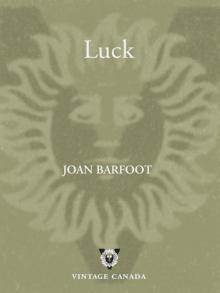Read Luck Storyline:
“There is good luck, and there is bad luck, and then there’s the ambiguous sort of luck that’s a lot of this and some of the other.”Philip Lawrence, a robust and pleasure-loving furniture-maker, dies suddenly at the age of forty-six. Though that’s terribly young by most standards, he’s lucky to have passed presumably peacefully in his sleep. Less fortunate, however, are the three women he leaves behind to make sense of his loss. There’s Nora, his wife of seventeen years, who wakes up next to his dead body. A fiery visual artist, Nora’s feminist re-interpretation of biblical themes stoked fundamentalist outrage from her small-town neighbours. Now, as her emotions run the gamut, she must confront solo life in a place she despises. Nora shares the house with Sophie, a buxom and bossy redhead, who works as the couple’s housekeeper and personal assistant. A recovering virtue addict, Sophie turns to menial tasks as a way to suppress painful memories of her two-year stint as an overseas aid worker. Philip’s death leaves her quietly reeling. And then there’s the pliable and vacuous Beth, a former beauty queen, who serves as Nora’s live-in muse and model. She mourns not Philip so much as the loss of a haven from her own creepy past. The novel follows the three days immediately after Philip’s death. Privately, each woman deals with memories and emotions, secrets and uncomfortable revelations, while at the same time preparing for the public rituals of mourning (including a funeral like no other). The narrative moves seamlessly from one perspective to another with delicious dark humour and wry insight into the nature of death, love, mourning, fundamentalism and luck. Barfoot’s tenth novel, Luck was shortlisted for the 2005 Scotiabank Giller Prize. The jury citation reads as follows: “Joan Barfoot is at the peak of her powers with this splendidly realized tragicomedy about a household in the wake of an unexpected death. With its note-perfect narration, mordant wit and wonderfully neurotic cast of characters, Luck shows how death can reveal life in all its absurdity and complexity. This scintillating comedy of manners is also a profound meditation on fate, love, and artifice.” From the Trade Paperback edition.From Publishers WeeklyStarred Review. Canadian novelist Barfoot (Dancing in the Dark) may finally get the recognition she deserves for this brilliantly conceived, masterfully realized 10th novel. Nora, a successful sculptor in her late 30s, wakes up one morning to find her custom furniture-designer husband, Philip Lawrence, 46, dead beside her. The rest of the novel simply follows her and the rest of the household, verité-style, as they make decisions and try to internalize what has happened over the course of that day and the two that follow. The rest of the household consists of Beth, a wispy former model who moved in to serve as Nora's muse over the past few years, and Sophie, a fleshy economist who burned out as an aid worker, and has been holed up with the other three as caretaker and financial manager. Barfoot makes the most of this uncomfortable ménage without overplaying her hand a single time: yes, Philip and Sophie were sleeping together, and yes, it's even possible that Beth poisoned Philip in order to get with Nora. Barfoot alternates among the three women's points of view with comic but never trivializing adroitness, and expertly spins out their backstories and recent lives together. The book is set in an English West Country town (with flashbacks to London), and there's a nice subplot concerning Nora's controversial use of religious imagery. But the real fireworks are in the minute explorations of this closed set of unorthodox relationships, all brought to a finish in a short coda set a year after Philip's death. Coming upon this novel is a fine piece of luck indeed. (Mar.) Copyright © Reed Business Information, a division of Reed Elsevier Inc. All rights reserved. From Booklist"What?" and "Now what?" are the fundamental questions the protagonists in Barfoot's novel ask themselves--again and again. Philip Lawrence "has the misfortune to die," and his wife, Nora, a sculptor, has the equal misfortune (or is it?) to wake up one morning to discover that Philip, lying beside her, has died during the night. Enter Beth, Nora's artist's model, and Sophie, the housekeeper; emotions among the women are high and run the gamut, and readers will quickly find themselves as shocked as Nora, Beth, and Sophie--after all, Philip always looked the picture of health and vitality. The narrative follows the three days immediately after Philip's death. Nora, Beth, and Sophie are a family of sorts, both before Philip's death and certainly after, and so this is very much a novel about family and home as well as death. It is at times disappointing; the basic story line is somewhat thin. But readers interested in a quick read, with its share of real life and real death, will find the book satisfying. Sarah WatsteinCopyright © American Library Association. All rights reservedPages of Luck :
